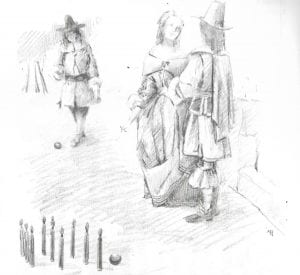The Origins of Bowling and Bowls
Bowling and bowls are games that have ancient origins. In regards to the origins of pin bowling, in 1930 a British anthropologist Sir Flinders Petries discovered a collection of objects in an Egyptian child’s grave that resembled the balls and pins used in playing skittles. The tombs content dated to 5200 B.C.
Games of bowls can be traced back to 5000 B.C. where Egyptians played a form of bocce with polished rocks. It is believed that Phoenicians, Egyptians, Greeks, and Romans invented an early form of bocce played by soldiers to pass the time in-between battles.
Pin Bowling
In Germany around 400 A.D., bowling had a deep religious significance. Parishioners carried a club-shaped cudgel, or Kegel as an exercise for arm and as a weapon. At that time the clergies devised a rather questionable test of a parishioner’s devotion to the faith. Each man would stand his Kegel on end and from the opposite end of the cloister’s runway, attempt to fell the pin with a round stone. The Kegel was the heathen in a man’s Soule and failure to topple the Kegel indicated a less-than-perfect attitude toward the church. The test evolved into to competition when priests themselves began bowling as recreation, not as a test of faith. Were the church cloisters then the first indoor bowling alleys?
In and around 1666, the Dutch game pf skittles had nine pins with the center pin or the “5” pin having a crown at it’s top. This probably was the origin of today’s practice of calling the “5” pin the Kingpin. In the 1770’s in England and later in Hungry, skittle pins were set-up on a wooden frame. Bowling one turn was referred to as bowling a frame.
Skittles is played all over Europe in various guises. Usually the game involves a round bowl being rolled at a set of skittles or pins, varying from one to nine. The game of Lengo-teke involves a set of nine pins placed on a wooden rhombus-shaped base and a bowl hung on a rope from a gallows. The bowl is aimed at the pins with a sweeping movement.
In the 1850’s, bowling in America was very popular but became associated with heavy drinking, gambling and often alleys were attached to building housing the “worlds oldest profession”. Massachusetts, Connecticut, and New York sought to “banish the evils” of bowling by passing legislation making bowling of “9 pin” illegal. The new laws created an opportunity for a radical change in the game when an unknown and unheralded benefactor to the game figured out a simple and effective way to circumvent the law against “9-pin” bowling by just adding one more pin, this then the creation of ten-pin bowling.
The next major innovation to the game took place in Worcester, Mass., when James Pin a former pin-boy (pinsetter) installed the first indoor bowling alleys and the course of bowling history was changed forever.





